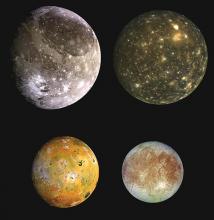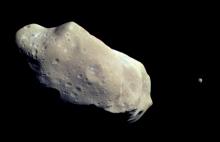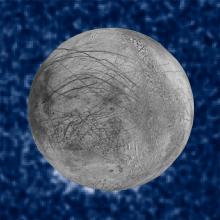You are here
Jupiter's Moons

Io: Fire World
Robotic probes may someday provide close-up views of some of the most remarkable vistas in the solar system, from the canyons of Mars to the ice-geysers of Triton. For a true hot-spot, they might show us the surface of Io, one of the moons of Jupiter. It is an eerie landscape of active volcanoes, tall mountains, and plains covered with frozen sulfur.
| Io | Europa | Ganymede | Callisto | |
|---|---|---|---|---|
| Discovery | 1610, Galileo Galilei | 1610, Galileo Galilei | 1610, Galileo Galilei | 1610, Galileo Galilei |
| Diameter | 2,273 miles 3,660 km |
1,944 miles 3,130 km |
3,270 miles 5,262 km |
2,985 miles 4,806 km |
| Distance from Jupiter | 262,000 miles 422,000 km |
416,700 miles 671,000 km |
665,000 miles 1.1 million km |
1.2 million miles 1.9 million km |
| Orbital Period | 1.8 days | 3.6 days | 7.2 days | 16.7 days |
Other than the Sun, portions of Io offer the hottest surface in the solar system. Several hundred volcanoes dot the surface, and they belch sulfur-rich lava that is hundreds of degrees hotter than the hottest lava on Earth.
Io's interior is heated by a tug-of-war between Jupiter and the planet's other big moons. Io is "locked" so that the same hemisphere always faces the planet, just as the same hemisphere of our own moon always faces Earth. But as the other moons move past Io, their gravity tugs at it, too. That heats Io's interior enough to melt some of its rock, which "bubbles" to the surface.
Europa: Water World?
For decades, Mars was considered the most likely home for life in the solar system. As observations continued to show a sterile, desolate world, though, scientists began turning their attention to Europa. Europa's icy crust appears to cover a large ocean of liquid water, where life may have gained a foothold.
Tidal gravity may have created the ocean by heating Europa enough to melt some of its ice.
There is abundant evidence of an ocean. The Galileo spacecraft found two types of terrain that may be related to water. "Chaotic" terrain looks like icebergs breaking off glaciers on Earth. The other terrain consists of smooth plains marked by ridges that are hundreds of miles long. The ridges may form as Jupiter's gravity rips apart the thin ice sheet. In addition, the motions of salty water below the surface may generate Europa's weak magnetic field.
Ganymede and Callisto: Ice Worlds
Ganymede is the solar system's largest moon -- larger than the planet Mercury. It consists of about half ice and half rock and metal. Grooves and ridges that crisscross its surface indicate that it has undergone great changes over the eons.
During several passes, the Galileo spacecraft saw mountains of ice, plus sheets of ice that erupted from volcanoes. It also saw deep canyons and broad, smooth plains created by the motions of Ganymede's crust.
Like Europa, Callisto's icy surface may conceal an ocean. The case for an ocean is more tentative, but it is bolstered by a huge basin on one side of the moon. It was created by a powerful impact billions of years ago.
But there is no jumble of rocks and mountains on the opposite side of Callisto, as there is with big impact basins on our own moon. A deep ocean could have cushioned the impact, preventing shock waves from piling up rocks half a world away.
| 1. Metis 2. Adrastea 3. Amalthea 4. Thebe 5. Io 6. Europa 7. Ganymede 8. Callisto 9. Themisto 10. Leda 11. Himalia 12. Lysithea 13. Elara 14. S/2000 J11 15. Iocaste 16. Praxidike |
17. Harpalyke 18. Ananke 19. Isonoe 20. Erinome 21. Taygete 22. Chaldene 23. Carme 24. Pasiphae 25. S/2002 J1 26. Kalyke 27. Magaclite 28. Sinope 29. Callirrhoe 30. Euporie 31. Kale 32. Orthosie |
33. Thyone 34. Euanthe 35. Hermippe 36. Pasithee 37. Eurydome 38. Aitne 39. Sponde 40. Autonoe 41. S/2003 J1 42. S/2003 J2 43. S/2003 J3 44. S/2003 J4 45. S/2003 J5 46. S/2003 J6 47. S/2003 J7 48. S/2003 J8 |
49. S/2003 J9 50. S/2003 J10 51. S/2003 J11 52. S/2003 J12 53. S/2003 J13 54. S/2003 J14 55. S/2003 J15 56. S/2003 J16 57. S/2003 J17 58. S/2003 J18 59. S/2003 J19 60. S/2003 J20 61. S/2003 J21 62. S/2003 J22 |
Teacher Copies
Request a free copy of The Solar System or Beyond the Solar System for your classroom. Bulk copies are available for $1.50 each in quantities of 30 or more. Shipping is included. Call 512-471-5285 for orders of 30 or more.
 The Astro Guides for the Solar System and Beyond the Solar System are supported by the National Aeronautics and Space Administration under Grant Nos. NNG04G131G and NAG5-13147, respectively.
The Astro Guides for the Solar System and Beyond the Solar System are supported by the National Aeronautics and Space Administration under Grant Nos. NNG04G131G and NAG5-13147, respectively.






